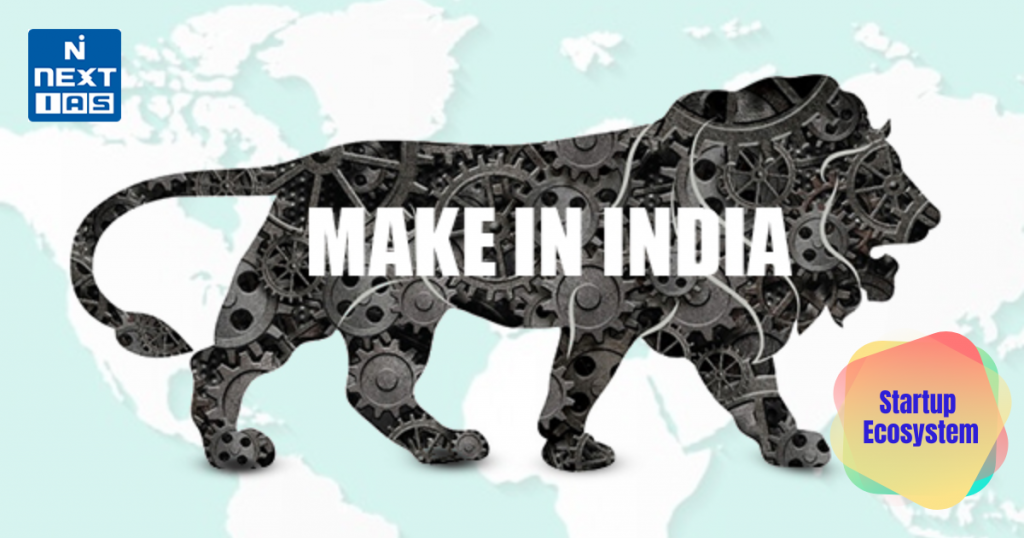
The Make in India initiative was launched by Prime Minister in September 2014 as part of a wider set of nation-building initiatives. Devised to transform India into a global design and manufacturing hub, Make in India was a timely response to a critical situation. By 2013, the much-hyped emerging markets bubble had burst, and India’s growth rate had fallen to its lowest level in a decade. The promise of the BRICS Nations (Brazil, Russia, India, China and South Africa) had faded, and India was tagged as one of the so-called ‘Fragile Five’.
About the Make in India
- Make in India is a flagship initiative launched by the Government of India in 2014 to transform the country into a global manufacturing hub. It aims to boost investment, foster innovation, enhance skill development, and build world-class infrastructure.
- The initiative focuses on 25 key sectors, including automobiles, textiles, electronics, and pharmaceuticals, to encourage domestic and international companies to manufacture in India.
- By simplifying regulations, improving the ease of doing business, and promoting self-reliance, Make in India seeks to create job opportunities and drive economic growth.
- The program has led to increased foreign direct investment (FDI) and policy reforms, such as the Production-Linked Incentive (PLI) scheme.
- With a vision of making India a competitive global player in manufacturing and exports, the initiative supports sustainable industrialization, technological advancement, and entrepreneurship, contributing significantly to India’s long-term economic progress and self-sufficiency.
Features of the Make in India
- Focus on Key Sectors
- The initiative targets 25 priority sectors, including automobiles, textiles, IT, pharmaceuticals, biotechnology, and renewable energy, to enhance industrial growth.
- Ease of Doing Business
- Make in India promotes reforms to simplify business regulations, reduce red tape, and improve India’s ranking in the Ease of Doing Business Index.
- Foreign Direct Investment (FDI) Liberalization
- The government has eased FDI norms in various sectors, allowing up to 100% foreign investment in industries like defense, railways, and construction.
- Infrastructure Development
- The initiative emphasizes building industrial corridors, smart cities, and better transportation networks to support manufacturing growth.
- Skill Development
- Make in India aligns with the Skill India program to enhance workforce capabilities, ensuring the availability of skilled labor for industries.
- Digital India Integration
- It encourages technology-driven manufacturing and promotes digital infrastructure to enhance productivity and innovation.
- Job Creation and Economic Growth
- By boosting manufacturing, the initiative aims to generate employment opportunities and drive India’s GDP growth.
- Startup and Innovation Support
- The initiative fosters entrepreneurship and research through programs like Startup India and Atal Innovation Mission.
Sectors Under ‘Make in India’ Initiative
Manufacturing Sectors
- Aerospace and Defence
- Automotive and Auto Components
- Pharmaceuticals and Medical Devices
- Bio-Technology
- Capital Goods
- Textile and Apparels
- Chemicals and Petro chemicals
- Electronics System Design and Manufacturing (ESDM)
- Leather & Footwear
- Food Processing
- Gems and Jewellery
- Shipping
- Railways
- Construction
- New and Renewable Energy
Service Sectors
- Information Technology & Information Technology enabled Services (IT &ITeS)
- Tourism and Hospitality Services
- Medical Value Travel
- Transport and Logistics Services
- Accounting and Finance Services
- Audio Visual Services
- Legal Services
- Communication Services
- Construction and Related Engineering Services
- Environmental Services
- Financial Services
- Education Services
Significance of Make in India
- The Make in India initiative, launched in 2014, is a major national program aimed at transforming India into a global manufacturing hub. It encourages both domestic and international companies to invest in manufacturing, thereby boosting economic growth, job creation, and technological advancements.
- One of its primary objectives is to increase the manufacturing sector’s contribution to India’s GDP, which helps in reducing dependency on imports and enhancing exports. By promoting local industries, the initiative strengthens self-reliance, aligning with the Atmanirbhar Bharat vision.
- A key aspect of Make in India is the ease of doing business, achieved through policy reforms, simplified regulations, and improved infrastructure. The initiative targets various sectors, including automobiles, textiles, electronics, pharmaceuticals, and defense, fostering innovation and skill development.
- Foreign Direct Investment (FDI) has seen significant growth due to relaxed policies, enhancing technology transfer and creating employment opportunities. By emphasizing sustainability and digital transformation, Make in India supports modern industrial growth while minimizing environmental impact.
- Additionally, the initiative has strengthened India’s position in global supply chains, reducing reliance on other nations for critical goods. It also boosts entrepreneurship by supporting startups and small businesses in manufacturing.
- Overall, Make in India is a crucial step toward economic self-sufficiency, global competitiveness, and sustainable industrialization, paving the way for a stronger, more resilient economy.
Lacunae of the Make in India
- Infrastructure Deficiency – India still faces inadequate infrastructure, including unreliable power supply, poor logistics, and slow land acquisition processes, which deter large-scale investments.
- Regulatory Hurdles – Despite improvements in Ease of Doing Business, bureaucratic red tape, complex labor laws, and slow decision-making processes continue to challenge businesses.
- Skill Gap – A major concern is the shortage of a skilled workforce. Many industries require specialized skills, but India’s vocational training and education system are yet to match industry demands.
- Low R&D and Innovation – India lags in research and development, crucial for high-tech manufacturing. Limited government and private sector investment in innovation affects competitiveness.
- Dependence on Imports – Many industries, especially electronics and defense, rely heavily on imported raw materials and components, reducing the effectiveness of local manufacturing efforts.
- Slow Implementation of Policies – Delays in rolling out key reforms like labor and land acquisition laws affect investor confidence and project execution.
- Global Competition – India faces stiff competition from China, Vietnam, and Bangladesh, which offer better incentives, lower costs, and faster execution of projects.
Key Pointers on Make in India for UPSC CSE Prelims
- Launched: September 25, 2014, by the Government of India.
- Objective: To transform India into a global manufacturing hub.
- Focus Sectors: 25 priority sectors, including Automobiles, Aviation, Biotechnology, Textiles, and Electronics.
- FDI Reforms: Liberalized Foreign Direct Investment (FDI) policies in key sectors.
- Ease of Doing Business: Simplified regulatory processes to attract investments.
- Infrastructure Boost: Development of industrial corridors and smart cities.
- Skill Development: Programs like Skill India to enhance workforce capabilities.
- Startups & Innovation: Promotion of entrepreneurship through Startup India.
- Make in India 2.0: Focus on 27 champion sectors, with emphasis on Industry 4.0.
- Achievements: Rise in India’s manufacturing output and global competitiveness.
Way Forward
To strengthen Make in India, the government should focus on infrastructure development, ease of doing business, skill enhancement, R&D investment, digital transformation, and sustainable manufacturing. Strengthening MSMEs, boosting exports, and fostering innovation through public-private partnerships will further enhance India’s position as a global manufacturing hub.
Conclusion
Make in India has significantly boosted manufacturing, investment, and job creation, strengthening India’s global economic position. While challenges remain, continued reforms, infrastructure development, and innovation will drive long-term success. With a focus on sustainability and competitiveness, the initiative aims to make India a global manufacturing powerhouse.






